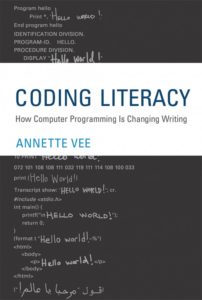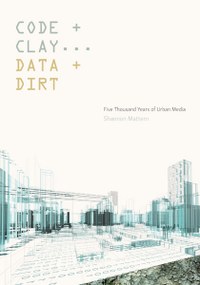“Media literacy” is as socially contested a term as they come. Its meaning of has been debated at least as far back as 1933 (see Tyner, 2010).It’s not difficult to make the case that Marshall McLuhan‘s work in the main was about media literacy. Not to mention Howard Rheingold‘s lengthy and thorough work on new media and social media literacy.
 So much has changed and changed hands since McLuhan left us. The computer moved from business and industry to the home and finally to every place and pocket available. In Coding Literacy: How Computer Programming is Changing Writing (MIT Press, 2017), Annette Vee argues that literacy is infrastructural. She explores two phases of its spread. One is where we adopt inscription technologies as material infrastructures. Then, as we adopt those technologies that affect the “quotidian activities of everyday citizens: literacy is adopted as infrastructure” (p. 141). She notes crucially that communicative practices such as writing and programming can manifest as actions and as artifacts. Vee’s approach addresses the social aspects of these literacies (i.e., understanding the actions), as well as their material underpinnings (i.e., understanding the artifacts). It’s an important new view of several serious issues.
So much has changed and changed hands since McLuhan left us. The computer moved from business and industry to the home and finally to every place and pocket available. In Coding Literacy: How Computer Programming is Changing Writing (MIT Press, 2017), Annette Vee argues that literacy is infrastructural. She explores two phases of its spread. One is where we adopt inscription technologies as material infrastructures. Then, as we adopt those technologies that affect the “quotidian activities of everyday citizens: literacy is adopted as infrastructure” (p. 141). She notes crucially that communicative practices such as writing and programming can manifest as actions and as artifacts. Vee’s approach addresses the social aspects of these literacies (i.e., understanding the actions), as well as their material underpinnings (i.e., understanding the artifacts). It’s an important new view of several serious issues.
 Zooming out to the walls, rooms, and roads around us, Shannon Mattern’s Code + Clay… Data + Dirt: Five Thousand Years of Urban Media (University of Minnesota Press, 2017) takes up the mantle of media archaeology and “challenges the newness of the new” by looking back at infrastructure at large — our built environment. Our urban areas are the site of information access as well as media themselves. Citing Malcolm McCullough and echoing McLuhan, She writes, “Our physical landscapes inscribe, transmit, and even embody information–about their histories, their state of repair, their potential uses, and so forth” (p. xii). Mattern’s use of sound, inscription, voice, and code illuminates our environment in a different and generative light.
Zooming out to the walls, rooms, and roads around us, Shannon Mattern’s Code + Clay… Data + Dirt: Five Thousand Years of Urban Media (University of Minnesota Press, 2017) takes up the mantle of media archaeology and “challenges the newness of the new” by looking back at infrastructure at large — our built environment. Our urban areas are the site of information access as well as media themselves. Citing Malcolm McCullough and echoing McLuhan, She writes, “Our physical landscapes inscribe, transmit, and even embody information–about their histories, their state of repair, their potential uses, and so forth” (p. xii). Mattern’s use of sound, inscription, voice, and code illuminates our environment in a different and generative light.
We academics do a lot of work to justify and perpetuate our own work, a lot of advertising for ourselves. This is not that kind of work. Both of these books are about current situations verging on crises, and both of them take a long, historical view of these situations. There is still much to learn about all of these constructs and all of their relationships. There is an entire network of literacies we all need to learn. Now.
References:
Mattern, Shannon. (2017). Code + Clay… Data + Dirt: Five Thousand Years of Urban Media. Minneapolis, MN: University of Minnesota Press.
Tyner, Katherine (Ed.). (2010). Media Literacy: New Agendas in Communication. New York: Routledge.
Vee, Annette. (2017). Coding Literacy: How Computer Programming is Changing Writing. Cambridge, MA: The MIT Press.
—-
Many thanks to Alison Langmead, Lily Brewer, and the fine folks at the University of Pittsburgh and their Digital Scholarship Services for hosting and allowing me to crash the Willful Transgressions: Transdisciplinary Teaching workshop with Shannon Mattern. It was there that I was able to meet and work briefly with both Shannon and Annette.
I marshal the middle between Mathers and McLuhan.
Editor of Boogie Down Predictions (Strange Attractor, 2022), author of Dead Precedents (Repeater, 2019) and The Medium Picture (UGA Press, 2025), among others.
